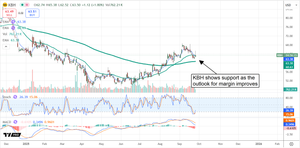
The S&P 500, after scaling new heights, has recently experienced a multi-day downturn, prompting investors to reassess their positions in a volatile market. This decline follows a significant move by the Federal Reserve, which implemented its first interest rate cut in nearly a year, aiming to mitigate risks from a softening labor market. However, subsequent cautionary remarks from Fed Chair Jerome Powell regarding equity valuations have injected a dose of skepticism, fueling market uncertainty.
Market Volatility Amidst Shifting Fed Stance
In late September 2025, the S&P 500 demonstrated a notable shift from its record-setting trajectory. After reaching an all-time closing high of 6693.75 on Monday, September 22, the index embarked on a multi-day retreat. It closed down 0.6% on Tuesday, September 23, followed by a further 0.3% decline on Wednesday, September 24, marking the largest two-day percentage drop since early September. This downward trend persisted into Thursday, September 25, with another 0.3% dip. The technology sector, a previous market leader, spearheaded these declines, with prominent companies like Nvidia (NASDAQ: NVDA) and Oracle (NYSE: ORCL) seeing their shares fall.
The catalyst for this market recalibration was a highly anticipated decision by the Federal Reserve. At its September 2025 Federal Open Market Committee (FOMC) meeting, the Fed cut its benchmark interest rate by 25 basis points, lowering the federal funds rate to a range of 4.0%-4.25%. This move, the first since December 2024, was largely driven by a weakening labor market, characterized by revised payroll numbers indicating slower job creation and a rise in unemployment to 4.3% in August. Despite inflation remaining above the Fed's 2% target, the central bank prioritized addressing the "downside risks to employment," framing the cut as a "risk management" strategy. The Fed's "dot plot" projections further signaled expectations for two more 25-basis-point cuts by the end of 2025 and an additional cut in 2026.
Initially, the market responded positively to the rate cut, with the S&P 500 pushing to new highs and small-cap companies enjoying gains, as lower rates typically ease financial conditions. However, this optimism was short-lived. On September 23, Federal Reserve Chair Jerome Powell's comments, stating that equity prices were "fairly highly valued" and that inflation risks remained "two-sided," significantly dampened investor sentiment. These remarks, combined with the traditionally weak seasonal performance of September for stocks, contributed to the ensuing multi-day declines. The market is now grappling with conflicting signals: the supportive nature of lower rates versus the Fed's cautious stance on valuations and persistent inflation concerns. This has led to a notable sector rotation, with initial beneficiaries like technology and growth stocks facing headwinds, while rate-sensitive sectors like utilities and dividend-paying stocks, along with gold, saw increased interest.
Corporate Fortunes Tied to Interest Rate Swings
The Federal Reserve's rate cut, coupled with the ongoing discussion about equity valuations, creates a distinct landscape of winners and losers across various sectors. Companies that rely heavily on borrowing for growth and operations are poised to benefit significantly from reduced interest expenses.
Potential Winners:
- Growth Stocks (Technology and Small-Caps): Companies with high growth potential, particularly in the technology sector, often depend on external financing for research, development, and expansion. Lower borrowing costs directly improve their profitability and make future earnings more valuable through discounted cash flow models. For instance, a company like Oracle (NYSE: ORCL), which may carry substantial debt for its AI infrastructure investments, could see reduced interest payments. Similarly, highly leveraged Software-as-a-Service (SaaS) companies like Thryv Holdings, Inc. (NASDAQ: THRY) could improve their bottom line. Fintech companies such as Block (NYSE: SQ) might also experience enhanced margins on credit products and benefit from increased consumer spending.
- Real Estate and Home Construction: Lower interest rates translate directly into more affordable mortgage rates, stimulating demand in the housing market. This is a boon for homebuilders like PulteGroup (NYSE: PHM), D.R. Horton (NYSE: DHI), and Lennar (NYSE: LEN), who are likely to see increased sales. The ripple effect extends to construction equipment suppliers like Caterpillar (NYSE: CAT) and building material companies such as Builders FirstSource (NYSE: BLDR) and Mohawk Industries (NYSE: MHK).
- Consumer Discretionary: With reduced borrowing costs for consumers, disposable income tends to increase, leading to higher spending on non-essential goods and services. Major players in this sector, including companies like Nike (NYSE: NKE), Disney (NYSE: DIS), and Tesla (NASDAQ: TSLA), could see a boost in sales. Retailers such as Target (NYSE: TGT) and Walmart (NYSE: WMT) may also benefit from increased consumer confidence.
- Utilities and Telecommunications: These capital-intensive sectors often carry significant debt loads for infrastructure maintenance and expansion. Lower interest rates reduce their borrowing costs, enhancing profitability. Companies like AT&T (NYSE: T) and NextEra Energy (NYSE: NEE) stand to gain from cheaper access to capital. Their steady dividends also become more attractive as bond yields fall.
Potential Losers (or negatively impacted):
- Financials (especially Banks): While some financial services, like brokerages, might see increased activity, traditional banks can face compressed net interest margins (NIM) – the difference between interest earned on loans and paid on deposits. Lower rates can reduce profitability for institutions heavily reliant on NIM. However, some investment banks, like Goldman Sachs (NYSE: GS), might benefit from increased capital markets activity if the rate cuts stimulate broader economic activity.
- Consumer Staples: While generally stable, these companies sell essential goods that consumers buy regardless of economic conditions. In an environment where rate cuts are meant to encourage discretionary spending, funds might shift from defensive consumer staples to more growth-oriented or cyclical sectors, potentially leading to relative underperformance.
The current market dynamic suggests that while the rate cuts are broadly positive, the high equity valuations, as noted by Chair Powell, indicate that much of this benefit may already be priced in, leading to a nuanced environment where selective investment strategies are crucial.
Broader Implications and Historical Echoes
The recent S&P 500 declines, occurring alongside the Federal Reserve's rate cut and subsequent cautious commentary, underscore a complex interplay of economic forces. This scenario fits into broader industry trends marked by significant market rallies driven by optimism around artificial intelligence (AI) and strong corporate earnings, yet tempered by persistent concerns over elevated market valuations. The P/E ratio of the S&P 500, hovering near historical highs, suggests a market potentially susceptible to corrections.
A critical trend is the expected narrowing of the performance gap between the "Magnificent 7" tech stocks and the broader S&P 493 in 2025 and 2026, with macroeconomic factors potentially favoring the latter. Policy uncertainty, particularly regarding tariffs, adds another layer of complexity, threatening to slow GDP growth and accelerate inflation, thereby fueling "stagflation" concerns. In this environment, earnings growth is anticipated to be the primary driver of market returns, rather than further valuation expansion.
The ripple effects of these developments are widespread. Technology and growth stocks, while benefiting from lower borrowing costs, remain vulnerable to valuation concerns, as evidenced by recent dips in giants like Amazon (NASDAQ: AMZN) and Microsoft (NASDAQ: MSFT). Highly leveraged companies across sectors will generally welcome reduced financing costs. Real estate and homebuilders could see increased demand due to more affordable mortgage rates, but this could be offset if inflation keeps long-term rates sticky. Conversely, cyclical, value-oriented, and smaller-capitalization stocks might outperform in a non-recessionary, accommodative monetary environment, given their higher leverage and reliance on external financing. The energy sector could also emerge as a hedge against inflation, benefiting from rising crude oil prices. Globally, a weaker U.S. dollar, often a consequence of Fed easing, could boost U.S. exports and benefit multinational corporations and emerging markets.
From a regulatory and policy standpoint, the Fed's September 2025 rate cut marks a pivotal shift towards a more proactive stance to support economic growth. However, the central bank faces a delicate balancing act: controlling inflation, which remains above its 2% target, while staving off a deeper economic downturn. Chair Powell's acknowledgment of "no risk-free path" highlights this challenge. Regulatory bodies will also be vigilant about potential asset bubbles if prolonged low-interest rates lead to excessive liquidity. Furthermore, anticipated trade policies, including targeted tariffs from the incoming U.S. presidential administration, could introduce significant uncertainty for corporate earnings and the global economy.
Historically, the S&P 500 has generally performed well during rate-cutting cycles, with average gains in the year following the first cut. When cuts occur near all-time highs, the index has also tended to move higher in the subsequent 12 months. However, context is crucial; rate cuts preceding severe recessions, such as in 2001 or 2007-2009, saw market declines despite monetary easing. The immediate aftermath of a rate cut can also be volatile, with the S&P 500 often struggling in the short term, suggesting that much of the optimism may already be priced in. Elevated volatility is a common feature before and after the first rate cut, underscoring the inherent uncertainty of such periods. While the market has shown resilience, concerns about overvaluation, reflected in high Shiller P/E ratios, continue to fuel fears of a "long overdue" pullback, drawing comparisons to past speculative bubbles.
Navigating the Future: Short-Term Swings, Long-Term Growth
The Federal Reserve's initiation of a new interest rate cutting cycle in September 2025, following previous cuts and an aggressive tightening period, sets a complex stage for the S&P 500 and the broader market. These actions, largely a response to a cooling labor market despite persistent inflation, have already seen asset prices adjust in anticipation.
Short-Term Outlook: Historically, Fed rate cuts, especially when the S&P 500 is near all-time highs and a recession is avoided, have been a constructive signal. The S&P 500 has typically traded higher in the 12 months following such cuts. Indeed, the index pushed to new highs after the September 2025 cut, with small-cap companies also reaching levels not seen since 2021. Projections from Goldman Sachs Research anticipate further gains for the S&P 500 in the next 6 to 12 months, driven by continued easing and the strength of large-cap stocks. However, the immediate aftermath of rate cuts can be volatile, with historical data showing potential dips in the first three months before a typical rebound by the six-month mark.
Long-Term Outlook: In the long run, lower interest rates are generally expected to boost investor confidence, stimulate investment and spending by reducing borrowing costs, and enhance equity valuations by lowering the discount rate for future cash flows. Projections for S&P 500 earnings growth remain robust for 2025 and 2026, with some forecasts suggesting the index could reach 7000-7700 points by late 2026. This optimism is underpinned by economic resilience, strong GDP growth expectations, and continued momentum in technology, particularly in AI. Nevertheless, the long-term trajectory is highly dependent on whether the rate cuts successfully navigate a "slowdown, not a slump" scenario, or if they signal a deeper, looming recession.
Strategic Pivots for Investors and Corporations: Investors should consider reallocating from cash, whose yields are expected to fall, into diversified portfolios. Long-duration and high-quality corporate bonds are poised to benefit from falling rates. In equities, a focus on growth stocks, particularly in technology and AI, alongside small caps and rate-sensitive cyclical sectors like homebuilders and consumer discretionary, could prove beneficial. Diversification into international markets, especially Europe and emerging markets, is also crucial, given stretched U.S. valuations and the potential for a weaker dollar. Alternative assets like gold and private real estate sectors (multifamily, industrial, data centers) also present opportunities.
Corporations should leverage lower borrowing costs for capital expenditures, strategic mergers and acquisitions, and refinancing existing debt. Investing in innovation and AI technologies will be critical for maintaining competitive edges and driving productivity gains.
Market Opportunities and Challenges: Opportunities abound in the continued momentum of AI, stimulated economic activity from lower borrowing costs, and strong corporate fundamentals. The commercial real estate sector could see a recovery, and global diversification offers new avenues for growth. However, challenges persist, including the risk of persistent inflation, the ever-present threat of a recession, and the narrow breadth of recent market rallies. Concerns also exist about structurally higher long-term rates and refinancing risks for companies that locked in low rates earlier in the decade. The potential for market "froth" and excessive leverage could lead to a "melt-up" followed by a "meltdown."
Potential Scenarios:
- Base Case (Soft Landing & Continued Bull Market): This most likely scenario anticipates continued economic resilience, further gradual Fed rate cuts, and positive S&P 500 returns driven by earnings and AI.
- Optimistic Scenario ("Roaring 2020s"): An extended period of exceptional market performance fueled by significant AI-driven productivity gains, potentially leading to a rapid surge in indices.
- Cautious Scenario (Growth Scare/Recession): If labor market weakness deepens, rate cuts could signal an impending recession, leading to significant market declines and necessitating a defensive strategy.
- Inflation Resurgence: Should inflation prove stubborn or re-accelerate, the Fed might be forced to halt or reverse its easing, introducing significant market uncertainty.
The market is at a critical juncture, balancing the supportive impulse of lower rates with underlying economic uncertainties and elevated valuations. Strategic agility will be paramount for both investors and corporations in navigating the path ahead.
The Fed's Balancing Act: A Market at a Crossroads
The recent trajectory of the S&P 500, marked by both record highs and subsequent pullbacks, against the backdrop of the Federal Reserve's pivotal rate-cutting cycle, paints a picture of a market grappling with complex signals. The primary takeaway is that while the Fed's easing policy is intended to be a supportive force for the economy and markets, its impact is nuanced and not without risks, especially given existing high equity valuations and persistent inflation concerns.
Moving forward, the market is poised for continued dynamism. Historical precedents suggest that rate-cutting cycles, particularly in the absence of a severe recession, tend to lead to positive returns for the S&P 500 over the subsequent year. The prevailing expectation is for a "soft landing," where the economy moderates without a significant downturn, bolstered by further anticipated Fed rate cuts through 2025 and into 2026. However, this optimistic outlook is tempered by the recognition that short-term volatility is likely, as investors digest economic data and the Fed's communications.
The lasting impact of this period will be defined by how successfully the Fed navigates its dual mandate of price stability and maximum employment, and how corporations and investors adapt to an environment of structurally higher, yet easing, interest rates. The AI revolution remains a powerful, long-term tailwind, but its concentrated market gains highlight the importance of broader market health.
Investors in the coming months should meticulously watch the Federal Reserve's subsequent rate decisions and official communications, particularly any shifts in its "data-dependent" stance. Key economic indicators, especially labor market reports and inflation figures, will be crucial barometers of the economy's health and the Fed's policy path. Corporate earnings reports, especially from dominant technology firms, will continue to be significant market movers. Finally, monitoring overall market sentiment, valuation levels, geopolitical developments, and potential tariff impacts will be essential for making informed investment decisions in this evolving financial landscape.
This content is intended for informational purposes only and is not financial advice





